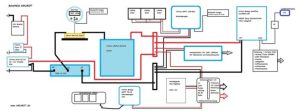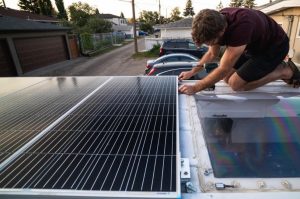How we live life off the grid with our mobile home
the grid with our mobile home
Electricity in the mobile home. What do I need? What do I not need? In this article, I would like to present my motorhome electrics. My RV power supply has grown to this level over the years. Unfortunately, I sunk a lot of money there because I thought there was a cheaper way. I live in a mobile home all year round, and that’s where robust, powerful, and durable technology is important. If I had chewed something clever right from the start, I could have saved myself two battery changes, several inverters, and solar charge controllers.
Electrical power in a mobile home is an often discussed issue, but it doesn’t have to be complicated! With today’s systems, users can enjoy the benefits of powerful electricity without worrying about vulnerable electronics or fussy blocks. Let 21st-century technology take care of all your energy needs.
Unfortunately, I have to find out repeatedly that many people only talk about half-knowledge they have picked up somewhere. The mobile home electrics installed in the AMUMOT truck result from my years of experience.
A look behind the scenes of a self-sufficient mobile home
With years of effort, I’ve outfitted my mobile home with an electrical installation that ensures complete independence from shore power. Achieving freedom without having to rely on infrastructure is my ultimate goal!

Battery charge while driving
- 24V starter battery/alternator
Renogy Cyrix CT automatic cut-off relay 12/24V 120A
- The relay switches automatically when there is sufficient voltage in the starter battery
- through and enables the Orion DC-DC converter to work
Renogy Orion DCDC 24->12V 80A
- A fixed voltage converter that delivers an adjustable 14.4V output voltage from 24V.
- Maximum current 110A for a short time, but limited to 80A in my case in the Renogy BMS
Why the Cyrix CT cut-off relay?
Quite simply, laziness. I didn’t feel like running an extra D+ line back to the Orion DCDC converter. The Cyrix isolating relay automatically detects when the starter battery is being charged and only then releases the current to the charging converter.
If the voltage of the starter battery drops below 25.6V, the connection is automatically disconnected. If this voltage is too low, you can also use the Cyrix CT Li, where the switching voltage is set higher, which protects the starter battery a little more.
solar charge
- 3x 190W Renogy monocrystalline solar panels
Lying flat on the roof
- 2x 100W Renogy monocrystalline flexible solar panels
Lying flat on the roof
- 2x 90W 72 solar cell panels (no name)
Lying flat on the roof
- Renogy folding module 190W
For the low sun in winter
- Renogy Energy solar charge controller SmartSolar MPPT 150/85
For the 950W roof PV system
- Renogy Energy solar charge controller SmartSolar MPPT 75/15
For solar folding module 190W
Why two solar charge controllers?
The folding module is a 36-cell module and cannot be connected in parallel to the 72-cell modules of my solar roof system. Therefore, it got a separate controller.
Inverters/ chargers
- Renogy MultiPlus 12/3000/120
- 120A charger
- 3000W real sine wave inverter
- Assist mode when shore power connection is weak
- Shore power input can be limited from 2-16A. So no flying fuses on the pitch
Renogy Energy 350W sine wave inverter
- For chargers and small consumers
- Emergency charger 40A
- Nothing more than a laboratory power supply adjustable from 10-16V and 0-40A
Do you need a second charger in the mobile home?
The emergency charger is left over from the times before the MultiPlus. The chargers kept dying for me. Be it due to Undervoltage on Spanish pitches or overheating due to continuous operation. I rarely use the charger now. If so, then mostly for other campers or as a jump-start device.
Renogy Energy battery monitor BMV702
- Calculation of the State of charge of the battery
- Current (A), Volt (V), State of charge (%), Amp-hours consumed (Ah), Current power (W), time remaining to empty (h)
- Data output to the smartphone via Bluetooth dongle
Renogy Energy Lithium (LiFePO4) battery
- An extreme number of cycles possible with maximum service life
- fully usable capacity compared to lead batteries (see comparison LFP/lead)
- Due to the lush overcapacity of the Winston LiFeYPo4 cells, I reach 450Ah usable capacity.
Renogy Energy battery management BMS 12-200
- Protection against under-voltage in the battery
- Protection against overvoltage in the battery
- Over temperature protection
- Charging the current limitation of the alternator possible
- Charging current limitation with unbalanced cells
Why generators are a must-have for anyone who spends time outdoors
I’ve tried all sorts of generators over the years. From the 100 Euro Güde two-stroke engine to various emergency power generators from Kipor, FME, Endress, and Volterra. All tested power generators were rubbish. Mostly they only ran for a short time and then quit the service.
All the China generators from Kipor and Voltherr do not even produce pure sine voltage. Only the 600-watt Güde, a two-stroke power generator, produced the purest sine voltage thanks to its synchronous generator, which was difficult to maintain.
Every load change was commented on with a clear speed fluctuation, which can quickly mean overvoltage or Undervoltage death for some devices.
The Honda I have owned for over 4 years now just runs. Not only does it do its job very quietly, but it also consumes the least fuel (with the same test load). Even after a year’s idle time, it always starts immediately.
Desired goal – self-sufficient
Because I’m on the road with my mobile home all year round, I need a power supply that is powerful enough to supply all my consumers and makes me independent. I can only go to an outlet every few days, or certain devices only work on shore power or a generator.
Since my travel behavior changes from Time to Time, and it can well be that I stay in one place for 2 weeks, the power supply must be guaranteed even without shore power and alternators.
Therefore the 570Wp (Update 2016 770WP) (Update 2017 950WP) off grid solar system on the roof, with the 100Wp solar folding module, which is mainly used in winter and on shady pitches. This energy yield is sufficient to be completely independent of additional battery charging, even in winter in the south.

Now the sun does not always shine, and especially in the German winter, there is a deficit from December to January, which I have to compensate for in other ways.
If the engine is already running, the alternator can charge 80A per hour into the battery, so one driving hour is enough for 1.5 days of downtime if I had 0Ah solar charging. However, the alternator charging current is only used when required and can be deactivated via a switch.
For longer downtimes in winter, the generator has to be used. The adjustable Multiplus with the 120A charger can be set to 3.5A shore power, which the Honda generator can handle without any problems and thus delivers a good 50A charging current for the battery. The running time in Germany in the winter of 2014-2015 was just 10 hours.
At sockets, when things have to be done quickly, the battery is recharged from 0 to 100% in a good 2.5 hours with a charging current of 100A. This means I am prepared for all situations and always have an alternative solution if a part should fail.
The icing on the cake of the electrical system is the 200AH 12V lithium battery, which helps the whole system perform at its best. Since the battery is no longer fully charged, I can now use 100% solar power. The refrigerator has been replaced with a compressor model, and I use excess solar power to generate hot water. This saves a good 150 euros in gas per year.
Due to the consistent revision of the electrical system, standby currents are almost non-existent, and by using energy-saving devices such as the Grundig LED television, 12V notebook power supply, energy-saving Microsoft Surface Pro 3, 3G LTE Wlan router, I was able to reduce the daily consumption from 180Ah to a good 60- 80Ah lower. That’s why 200Ah in lithium is now completely sufficient.
